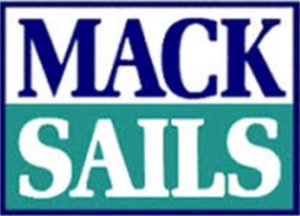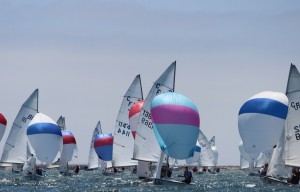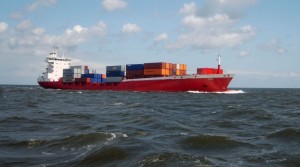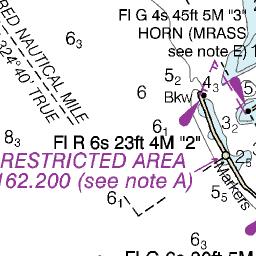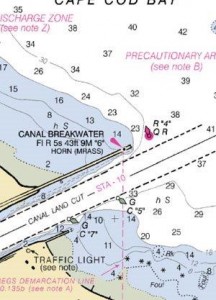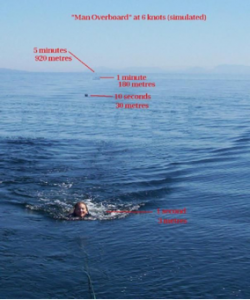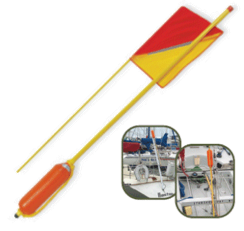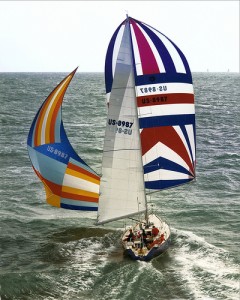Forespar's Point of View
Blogging About Life on the WaterCategory Archives: General Content
Keep Your Nose Up
One of the first times I ran outside the harbor on my own, the waves were small and relatively smooth. But when I returned a couple of hours later, the tide had changed against the wind, the chop had turned into waves, and the breeze had gone from eight to about fifteen knots. And, of course I was coming downwind with following sea. In a 14-foot centerboard boat. With all the vast experience and skill of a 12-year old.
Eased the centerboard up, surfed down the face of the wave, stuffed the bow and broached the boat. After what seemed like a dozen times almost righting the boat, a real sailor came up (in a power boat) and instructed me on getting the main in the boat, the boat upright and into the harbor, wet cold and alive. I’ve tried to repeat the experience in larger boats, but was unable to replicate the conditions, probably because there’s usually crew aboard who don’t want to get that wet, and I have many more years of experience driving boats. I’ve even tried to do the same thing with a power boat, almost succeeding due largely to inattention.
Three basic lessons learned for following seas:
- Trim the bow up. That’s why sailboats seem to keep the weight in the stern when running down the sea. If you’re in a power boat, pay attention to the trim tabs.
- Learn to surf the boat. Do not drive directly down the wave, because the bow will slow the boat when it hits the back of the wave ahead, and the following sea is likely to push your stern to the side, inducing that “I wanna broach ” motion.
- Unless you’re racing, try to find a spot on the back of the wave – a lot easier to do with a power boat – so you don’t get pushed around as much or as suddenly. In other words, slow down to the speed of the wave if you can. It’s safer and a whole lot more comfortable.
The oft used cliche “Slower is smoother, and smoother is fast” sounds odd, but it applies. You’ll reach your destination both drier, and happier.
Mack Sails & Forespar – A Solid Combo
Something Big This Way Commeth …
when in 1967 Swedish Sailmakers, a Fort Lauderdale fledgling sailmaking firm, partnered with lifelong sailor Brad Mack and Bradford Mack & Co was launched. For the next 20 years, the company continued to expand and in 1988 moved to Stuart, FL and was renamed Mack Sails. Over the years the company has expanded to include a full service rigging shop and a complete marine electronics service . Every Mack Sail is made in Stuart, FL and “…we insist that each one is made from the very best cloth and hardware.”
Brad Mack’s two sons, Travis Blain and Colin Mack , grew up in sail boats racing, cruising, or in the sail loft “learning the ropes.” After college Travis and Colin officially joined the firm and in 2002, took the helm, sharing the management and striving to deliver an extraordinarily designed and crafted product.
Colin and Travis remember the old days when they were ‘sponges’ learning everything possible at a rapid fire pace. “The lessons have all paid off because without the encouragement and guidance of our dad, the company could never have become what it has today.”
For close to 50 years the family tradition of pride and commitment to quality service sets Mack Sails apart based on these standards:
- Pride in every sail we manufacture – all designed for speed and durability
- Only the highest quality U.S. woven and finished cloth and tapes are used in our sails
- Hands on customer service begins with the initial contact and continues all the way through sail and rigging delivery and installation
Strong relationships have played a significant role in Mack Sails’ growth. In 1967, a key affiliation with Forespar began when Brad reached out across the U.S. for like-minded entrepreneurs who held similar strong business and family values. For the next 40 plus years, the Mack Sails and Forespar® relationship thrived and remains an industry symbol of ‘partnering for progress’ for both entities.
What the collaboration with Forespar stands for is simple, according to Travis. Mack Sails has worked with them on many projects (one of the first hydraulic Leisure Furl™ booms – aluminum or carbon fiber booms offer safety and convenience of In-Boom mainsail reefing and furling systems from the safety of the cockpit .)
“Collectively, we pooled resources and were the first ever to design and install a large roached full batten main for a Leisure Furl™ boom furling system on a Lagoon 440,” said Travis.
Colin says, “Throughout this journey, we’ve blended excellent products and service that satisfies the most demanding and rigorous standards that sailors demand. Forespar makes the boom furlers, and we make the sails and install them (riggers and sailmakers). This collaboration extends beyond the U.S., with LeisureFurl installations most recently as far away as Italy and Trinidad.”
“Forespar has developed a very good LeisureFurl™ design that allows Mack Sails no restrictions on multi-hulls; because of that we sell more of their booms and we install the boom systems and sails in sync, ” Colin concluded.
Forespar Vice President Bill Hanna sees the strong bond between both companies as a significant advantage to Forespar’s success over the years. “Though they are located in Florida, the Mack Sails team is always a phone call away…it’s as if they were in the office right next door. Our collaborations have become almost seamless because we’ve shared building and delivering quality boom systems, sails and rigging for nearly 50 years!”
Mike Dwight
Get the Kids on the Water!
It’s about time.
US Sailing and others are pushing to get kids and young people out on the water sailing. Not necessarily racing, but sailing.
My suggestions may be facile, but: (a) Start them early, and (b) Keep them involved in the process when they’re out there – no passengers.
Our primary YC offers one of the finer Juniors’ programs on the West Coast. While we have some superb racers in the Junior ranks, many race in the Harbor for the competitive fun of it, many sail just for the fun. We start Juniors in the “Starfish” program at about age five, when we can. They’re more at summer camp than on the water, but they are exposed to fun part of boating, with a dose of responsibility. that can then graduate to on the water, first sailing with coaches, then Sabots (racing if they want to), then Optis, then Lidos for fun, or 420’s to race, etc.
And, while we’re at it, there are a number of racing skippers who make sure that competent (meaning safe) juniors, mostly adolescents, crew on their boats for local PHRF races, and even on some of the distances races – again, no passengers. One skipper sailed the Newport-Ensenada race with eight kids and four adults, finishing fifth in a class of 15. All the juniors on that crew are sailing. Five are still racing , three on a national level, and three sail for fun.
The end result has been sailors who started in the Club at five, with about half of a twenty-year program philosophy still sailing (and that doesn’t count the power boaters). That means BCYC Junior sailing program has produced about 200 sailors still on the water, and more than that overall in recreational boaters.
That also means a pretty good crew pool for those of us who race a lot.
Make it fun, and they will come.
Drone Ships on the Way?
Unmanned freighters appear to be on the horizon, and headed our way. We’ve got unmanned spacecraft and drone aircraft and driverless cars, so why not unmanned ships?
Plans for operating unmanned ships were unveiled last month, when Rolls Royce presented a prototype control center, from which crews of seven to 14 people can control fleets across the globe. The mechanics of remote control are already in hand – many of us have some form of auto-pilot on our boats, so it’s not that much of a leap, despite the instant questions: What if something breaks? What about that satellite glitch – as in recent GPS issues?
Those of us who sail, fish, cruise or all of the above in waters off major ports such as LA, New York, Miami, Tampa, Seattle, etc., take some comfort in knowing that those windows on the bridge have a human or two who are actually looking though them for large and small obstacles.
I’ve even seen a ship coming into Long Beach slow to allow a race fleet to pass in front, because some skippers thought they could make it under his bow – I can tell you that if he hadn’t, there would have a been a couple fewer sailboats on the ocean, and the gene pool would have been a bit smarter. That’s the exception to the rule. As we should know, ships don’t have brakes, and that’s a lot of mass moving, usually faster that we are.
So, let’s pay attention to developments on the concept. Colregs and sanity aside, whether there’s a human at the helm or a drone operator in Finland driving that ship, the “law of tonnage” applies (something that we at Forespar understand). Risking your boat and crew on someone else’s satellite link might not be the best plan for longevity.
Mike Dwight
What’s The Yellow Pole with the Orange Flag?
That head in the water is getting away from you at 10 feet per second, and you’re only going six knots. So, in the five seconds it takes you to react, she’s already 55 feet away. 10 seconds, she’s 110 feet astern. If there’s any kind of sea running or a foot of chop, how long before you lose sight of that head, life jacket or not?
Just for training, wad up a paper bag or some wrapping paper, or blow up a balloon to about the size of your head. Toss it over side when you’re under way, and time yourself. It can be hard to find.
That’s why savvy sailors have that yellow pole with the orange cylinder at the base up along the rigging at the back of the boat. It’s a MOB (Man Over Board) pole.
The MOB pole is attached to the stern pulpit at the base, and to the backstay, enclosing the flag at the top. 50 or more feet of line (yellow) is tied to the float on the pole, and the other end to your horseshoe buoy. The picture below shows the basic pole in two parts for shipping, and how it might be mounted.
Deploying the pole is simple – a quick reach back from the helm, lift the pole from its seat, and drop it, reach over, and throw the horseshoe – not necessarily in that order – as long as it’s done quickly.
Now, there’s a high-visibility flag and pole six to ten feet high in the immediate vicinity of your overboard crew. The skipper and crew can track the person the water using the flag, making it much easier to take in sail and get the boat around and back to that flag. You will come up on the windward side of the flag, grab the pole, and reel in the horse shoe with the errant crew member.
A number of sailboats, particularly racers, have an installed horizontal tube, open at the transom. The pole in inserted flag end first, with the line coming out of the transom to the horseshoe. The horseshoe is thrown, and the resulting drag pulls the pole out toward the person in the water.
Many skippers attach a light to the pole. You may not see the pole/flag at night, but you will see the light. Obviously a good idea, and one we’ve used for years of cruising and offshore racing.
Get the pole and install it. You may never need to use it, but if you do, you will need it.
Mike Dwight
Great Reflexes
Closing at more than 40 knots, and no time to trim, duck or do anything except the right thing obviously gets interesting fast. We think this is scary at eight knots. Who was that said “…watching a sailboat race is like watching paint dry.”?
Bloopers
Ocean racing is just about to become more colorful – again!
The new ORR rules are allowing bloopers on non-sprit boats (with some restrictions). For sailors who don’t remember, look at the picture, and check out the big sail tacked to the port bow.
Look at the wake, and the waves, and realize just how deep and fast they’re sailing. Pole back a bit, ease the main a bit, and trim on the the blooper and that boat is still launched – even dead down wind. In light and moderate air, you’ve got a big downwind sail you trim with the halyard. You’ll want a racing crew with someone who either has or can develop a different set of trimming skill, but you’ll make up for it with VMG and boat speed. That blooper helps narrow the gap between an older boat and the sprit boats.
We’ll see them this year on the ocean races such as Bermuda, Transpac and Mackinac.
The ORR rule limits blooper use by treating the blooper as headsail (no pole), and within the number of sails the boat is allowed to carry. It has to be attached to the bow, and there are restraints on the boats allowed to fly them, as in basic design from before 1986. And couple of cautions: Think oscillations. Think about a little too much breeze and an interesting round up or crash jibe.
On the other hand, think speed.
Mike Dwight
Rights of Others on the Water
Not everyone shares your taste in music. Or sports. Or boats. Or recreation. Or wakes. Or engine noise. Or even beverages. Even if they do, they probably don’t want to share right now.
It’s easy to get totally focused on what you’re doing, even in a shared environment. Let’s face it: when you’re cranking along at 25 knots, your attention is on making sure you don’t hit anything solid, and the exhilaration of speed on the water. You’re not looking back at your wake, and seeing how much the swimmers, paddle boarders and kayakers appreciate it. Or how much the waterfront folks enjoy watching their watercraft bang on the dock. And the people out for a quiet day fishing really want to compliment you on your speakers and how loud your motors are.
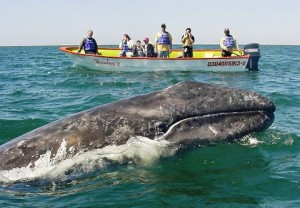 They’re just as happy as you are when you’ve just nestled in to bed after a long day on the water, and someone drops anchor next to you, invites friends, fires up the generator, plugs in the blender and the music, and parties down until the crack of dawn.
They’re just as happy as you are when you’ve just nestled in to bed after a long day on the water, and someone drops anchor next to you, invites friends, fires up the generator, plugs in the blender and the music, and parties down until the crack of dawn.
The long and the short of it is that you ARE in a SHARED environment.
Even the gray whales in Bahia Todos Santos shy away from noisy boaters, and bass in the lakes don’t really flock to rock and roll.
Respect the rights of others. Show some consideration for the people around you.When you’re at the launch ramp or the dock, be quick and make room for the next boat. Respect the private property along the shore. Make sure you have permission to go ashore, use the dock, or cross their land. And so on….
Remember, the other folks in or on the water have the same rights you do. And, just like you, all they want is a good day on the ocean, lake or river.
~ Mike Dwight
